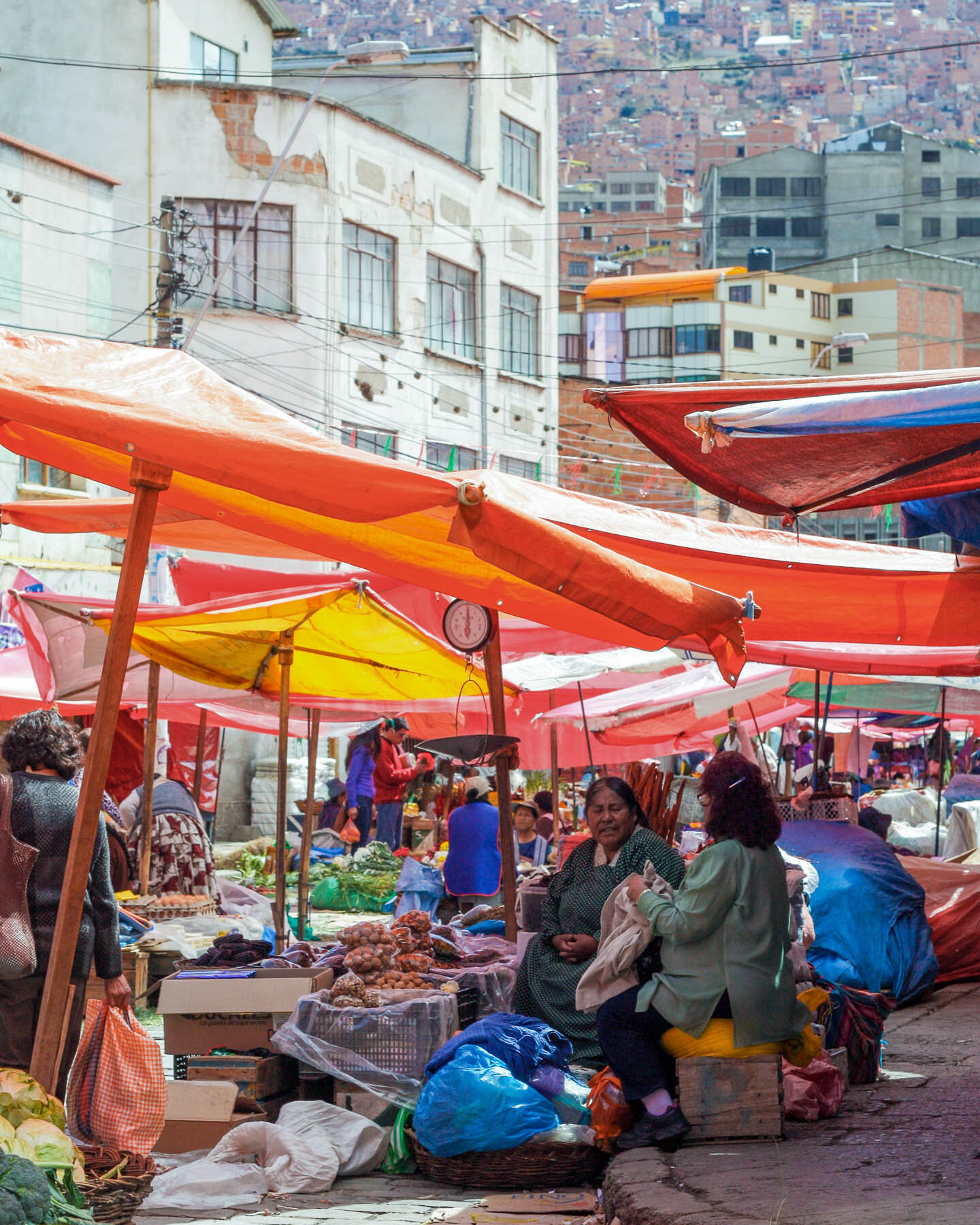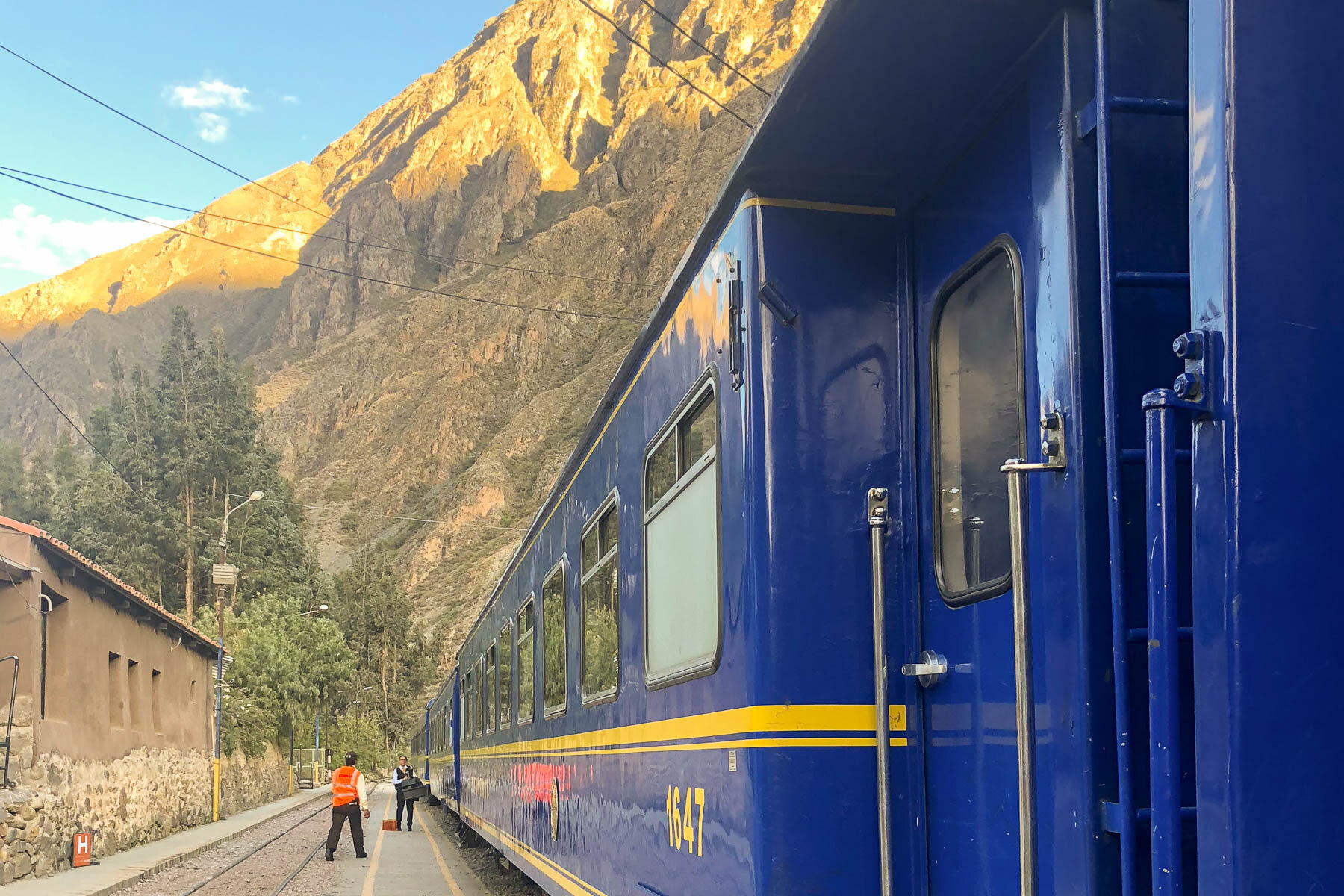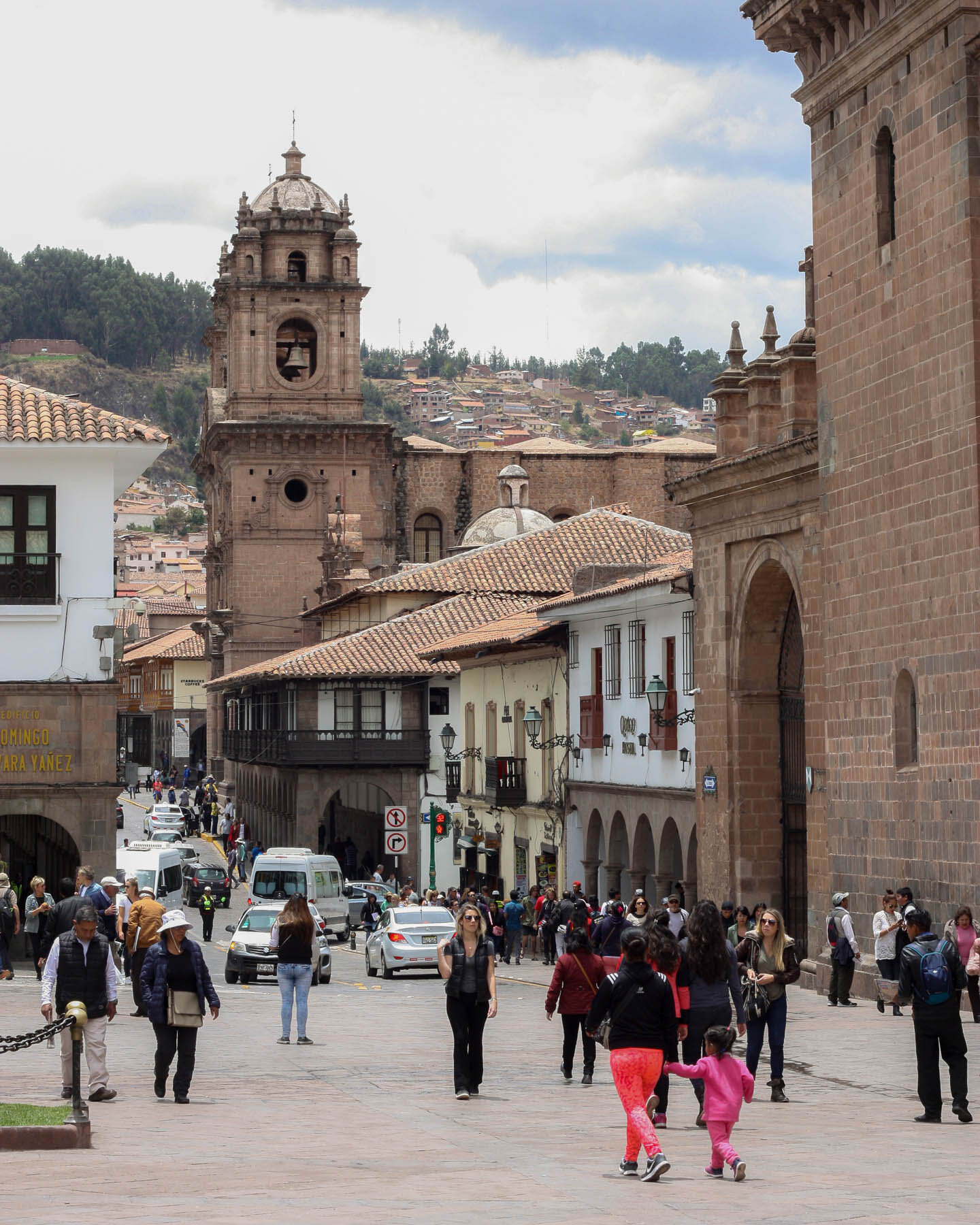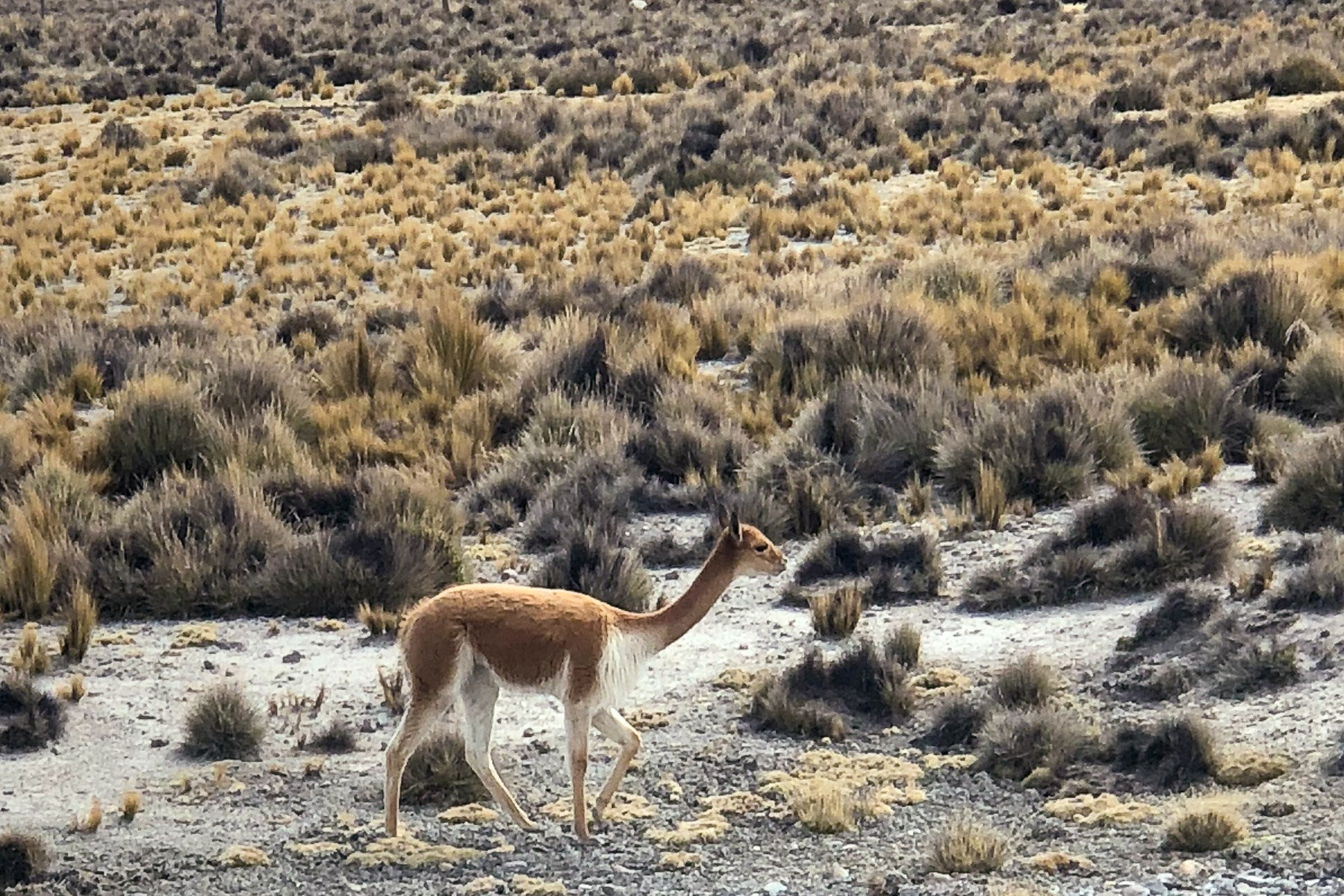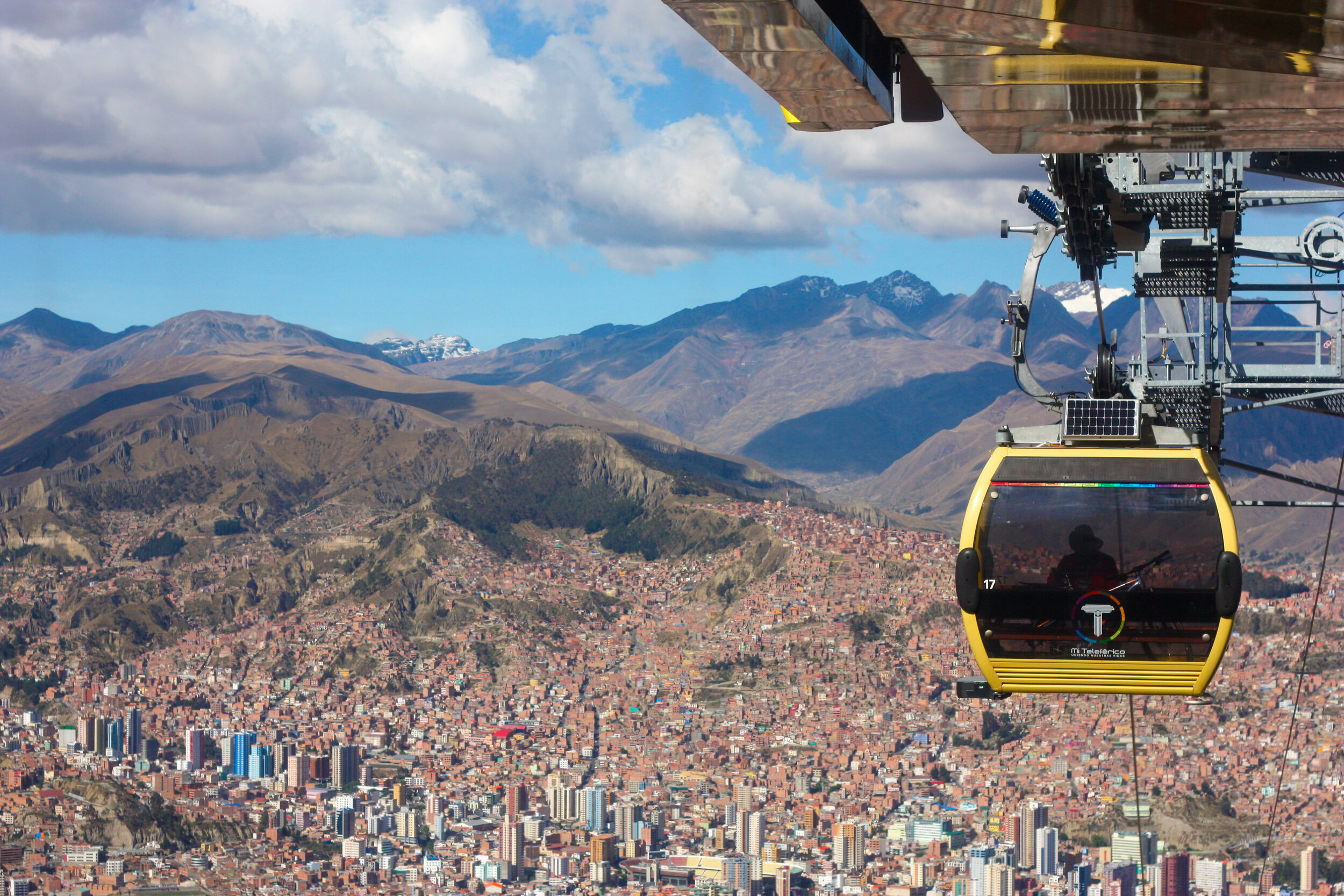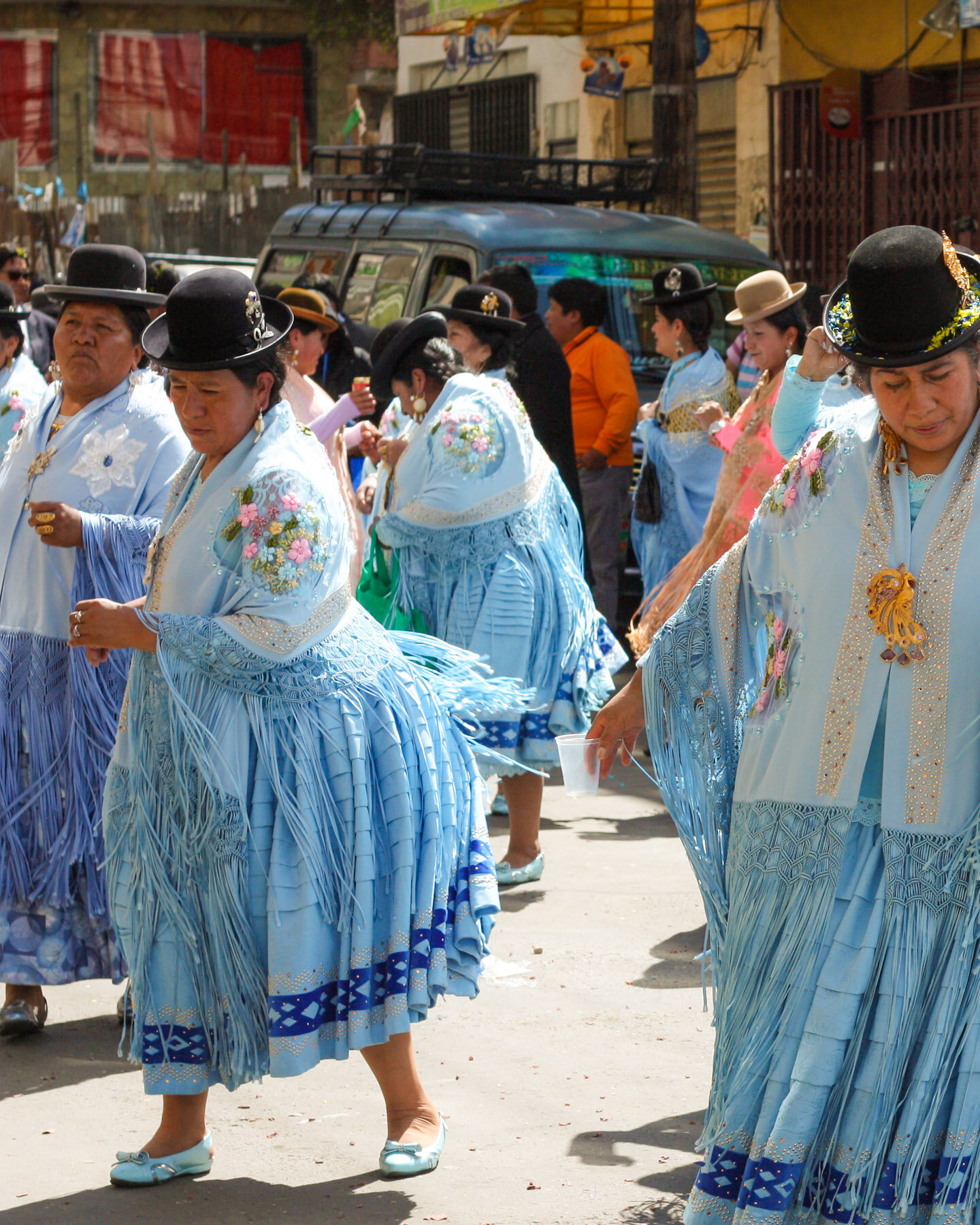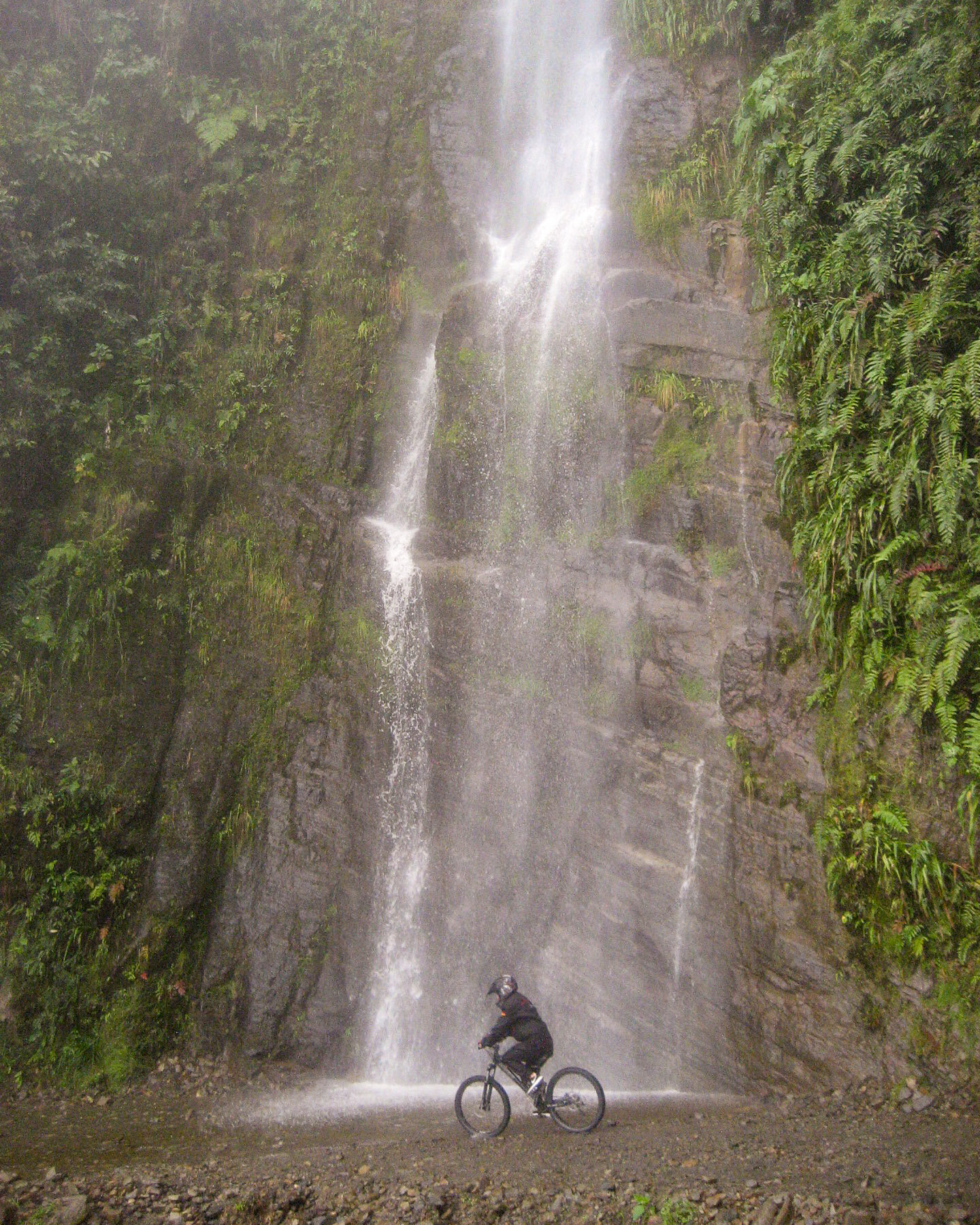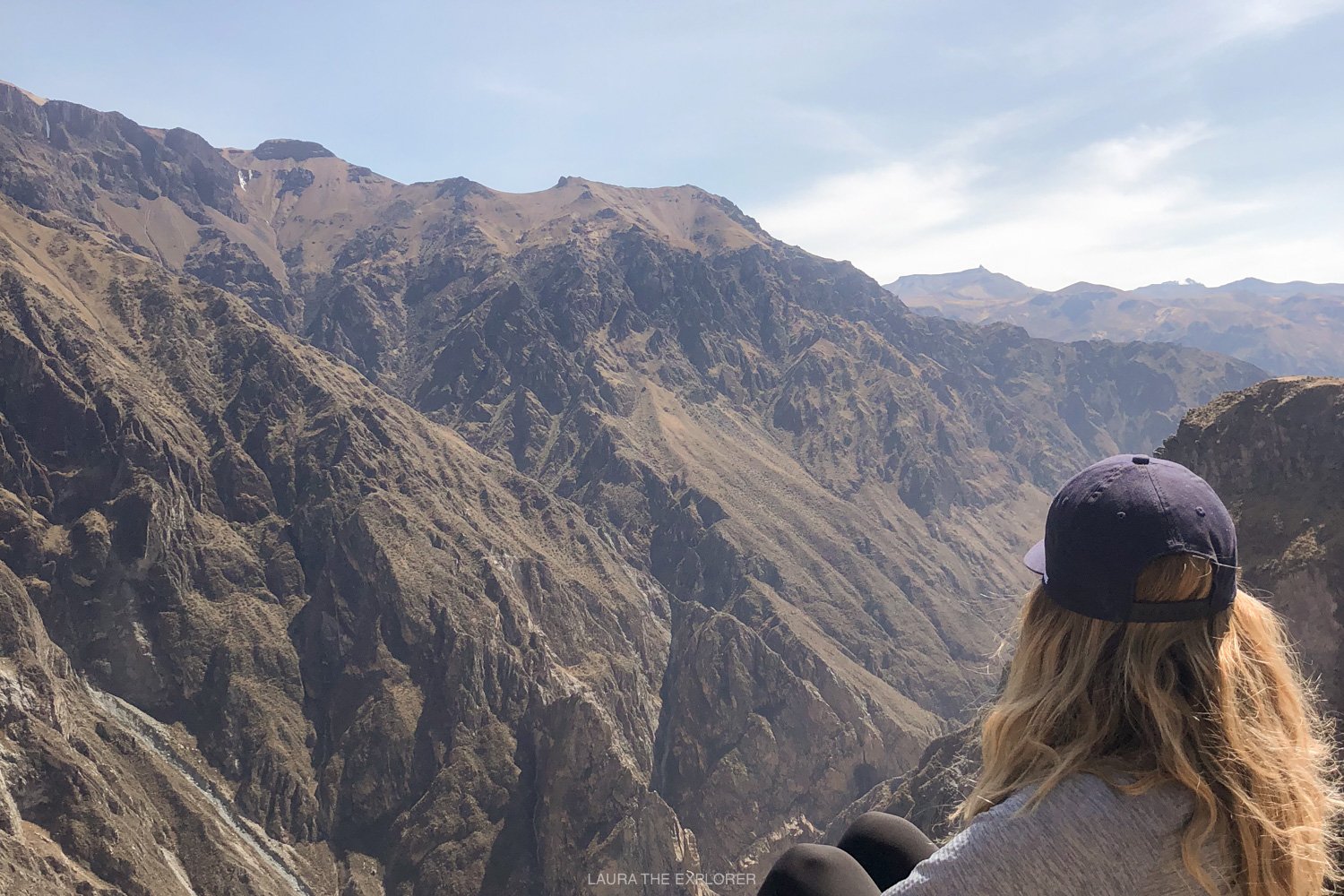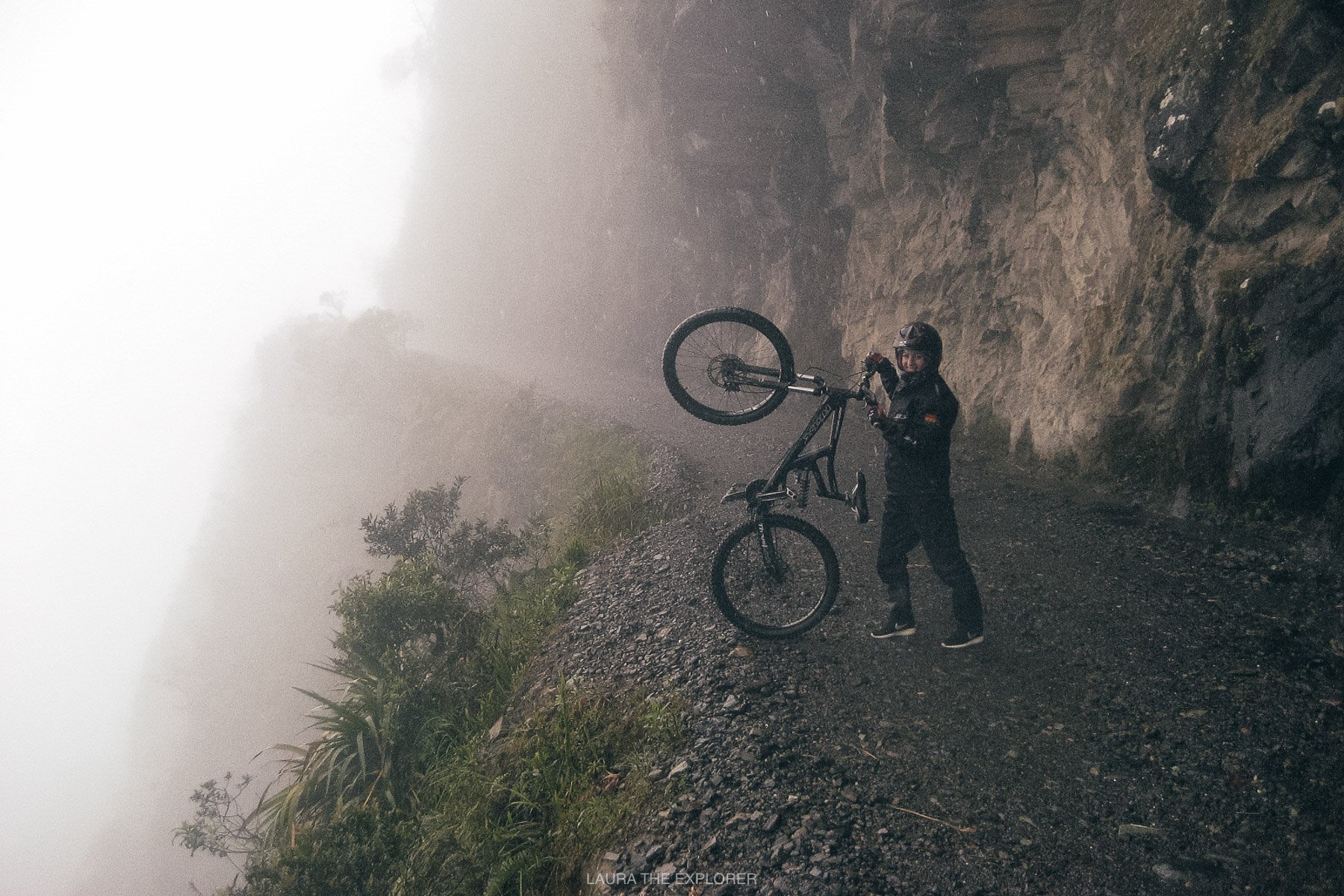Three Weeks in Peru & Bolivia
Plan an adventure to explore the rich heritage, hike the world’s iconic treks and experience landscapes that look like another world altogether.
This guide contains everything you need to know for three weeks in Peru & Bolivia.
These two countries always feature heavily on a South American backpacking route, however it’s totally possible to visit Peru & Bolivia independently on a shorter, dedicated adventure holiday.
From the South Pacific Coast, to the misty peaks of the Andes, across the altiplano deserts, to the depths of the Amazon jungle, the hardest part is deciding which of the amazing highlights to add to your itinerary - however there really is no wrong answer and the options are as diverse as the landscape. Combine this all with a delicious cuisine and warm, welcoming locals, a trip through Peru & Bolivia will be completely unforgettable.
Like many people, the duration of our adventure was going to be set by our annual leave balances. Balancing work commitments with our dreams of South American adventures, we would have three weeks of freedom to explore these amazing countries.
After lots of research and planning, our itinerary was formed around pre-set Inca Trail trekking dates that we locked in asap.
Starting in the cosmopolitan centre of Lima and on to the old Inca captial Cusco and Machu Picchu, the ‘white city’ Arequipa and incredible Colca Canyon, the floating islands of Puno before heading around Lake Titicaca to the hustle and bustle of La Paz, the other-wordly Uyuni salt flats and the high-altitude national reserves, our diverse three week itinerary is detailed below to provide inspiration for your own adventure.
Based on our experience, here are the things to get your started when planning a trip to Peru & Bolivia.
GETTING TO PERU & BOLIVIA
» AIR
Lima Airport is a hub for several airline and as such, is easily accessible from across South America and has many connections from all over North America.
Flights from Europe will typically connect through Madrid or Paris to Lima.
From New Zealand & Australia, flights to Lima run via Santiago, Chile (with LAN Chile), or via Buenos Aires, Argentina (with Air New Zealand).
» LAND
Bus connections to/from Lima are available from Ecuador, where there is a direct bus from Guayaquil to Lima. Cruz del Sur is the most highly rated service for safety and comfort.
To depart Bolivia by land, there are bus connections to Chile (to San Pedro de Atacama at the end of a salt flats tour), Argentina (such as to Salta) and Brazil (such as Corumba), and also train connections from south/east Bolivia on to Argentina and Brazil.
The quality of buses in Bolivia is not as high as Peru, so I’d recommend checking current reports as to which company to go with. Details on bus travel with Peru & Bolivia as covered further on in this post.
VISA REQUIREMENTS
» VISA REQUIREMENTS FOR PERU
Travelling on Canadian and New Zealand passports, entry to Peru is visa-free for touristic purposes up to 90-days. Ensure your passport has a minimum 6 months validity.
Many countries have a similar arrangement, with the official list available on the Peruvian Consulate website (download the document “Visa Requirements for Foreign Citizens”).
Peru utilises tourist immigration cards (known as TAM). Flying into Lima, these are completed automatically online, however if you arrive by land, you’ll fill in a hard copy document.
» VISA REQUIREMENTS FOR BOLIVIA
Travelling to Bolivia is also visa-free for Canadian and New Zealand passports holders, initially for 30 days but can be extended up to 90 days. Your passport also needs 6 months validity for Bolivia.
On arrival at the border from Peru, you will fill in a TAM card (it’s nice and easy) which you should keep safely with your passport. Hold onto this card until it gets collected as you depart Bolivia.
Read More: The Peru - Bolivia Border Crossing (coming soon)
WHEN TO VISIT PERU & BOLIVIA
Though Peru and Bolivia are located in the tropics, the climate fluctuates widely based on location, with huge difference between the coast, the Andes and altiplano, and the rainforests.
Typically, the summer months (Dec-March) are the rainy season. It’s wet, but temperatures are generally warmer. The dry season, from March to October features dry but cooler days and is generally considered the peak tourist season.
For the best weather in Peru & Bolivia, pick the best season to suit the activity that is most important for your trip.
For example if blue skies over Macchu Picchu are your preference, opt for the dry season for the best chances, but be aware that July and August also come with the biggest crowds.
Alternatively, if experiencing the mirror effect in the Salar de Uyuni is a must, then the wet season is the time for this, but be aware that The Inca Trail is closed the month of February.
CURRENCY IN PERU
The official currency of Peru is the Sol (plural: soles).
On currency conversion sites, the abbreviation for Peruvian Soles is PEN and prices in Peruvian stores will be displayed as S/.
» CASH
US Dollars are the easiest and preferred currency to convert in Peru, even to the extent that tours, transport and accommodation providers will happily accept Dollars (usually offered at the days current exchange rate, though do double check and know your conversion). Euros will give you little trouble also.
US Dollar can be exchanged at banks or currency exchange offices (Casas de Cambio). Casa de Cambios operate professionally and are safe place to exchange bulk amounts of currency. Banks are also super straightforward but note that the operating hours may make them a slightly less accessible option, especially as they are closed on Sundays. You may be required to present your passport.
Lima Airport, as with most other airports around the world, is not the best place to exchange currency due to inflated rates. Official taxi booths and the express shuttles above will all accept US Dollars, so it’s better to wait until you arrive in the city.
» CAMBISTAS
Cambistas, street exchangers, are surprising an easy, legitimate way to exchange cash (typically USD or Euros). They can be identified by their magenta vests and will carry a QR proving their registration. In Miraflores, I’d recommend using these guys to make smaller exchanges, to avoid any issues flashing cash out in full public view.
» ATMS
ATMs are available all over Lima, particularly in the Miraflores district and can typically be accessed out of bank hours. It can be a bit hit or miss finding compatibility between the bank and your card’s bank, so you may have to try a few. International banks seemed to be more successful for my ANZ card.
◇ TIP: DAMAGED NOTES
Be aware that due to counterfeiting issues, ripped or damaged notes can be problematic to exchange. Make sure to check all the notes you receive for their quality, as it can be really difficult to use these for payment - local Peruvians nearly always check the bills for accepting them, and they’re unlikely to accept a damaged bill. If you receive one in a transaction, simply ask the vendor for it to be replaced at the time.
CURRENCY IN BOLIVIA
The official currency in Bolivia is the Boliviano.
On currency conversion sites, the abbreviation for Bolivian Bolivianos is BOB and prices in Bolivian stores will be displayed as B$.
» CASH
As in Peru, exchanging US Dollars is very easy. Dollars are considered of value in the main tourist regions of Bolivia and it’s possible to pay for quite a lot of things in either Bolivianos or US Dollar. Dollar notes are preferred crisp and clean.
The exchange rate is published daily so keeping up to date with the rate and checking the math on transactions should mean you avoid being ripped off on any exchanges.
It is helpful however to carry Bolivianos for smaller purchases and in less accessible areas.
Similarly to Peru, banks, casas de cambio and cambistas are an easy, accessible way to exchange currency in the main tourist centres and banks are available in Copacabana, La Paz and Uyuni.
ATMs are available throughout the main centres also, though be aware that only Visa and Mastercard are likely to be accepted.
Some ATMs offer either Bolivianos or US Dollars. Check the exchange rates as sometimes the banks rates for Bolivianos are much lower than what is available at a casa de cambio. If this occurs, withdraw USD and exchange these to BOB at the casa de cambio.
Avoid purchasing Bolivianos at the border crossing (the rates aren’t favourable) and instead wait until you arrive in Copacabana. We exchanged currency easily in a shop displaying a cambio sign (though most likely unofficial) near the main square and had no problems. They’ll exchange both USD and any leftover Peruvian Soles.
◇ TIP: At the end of your trip, try to use up as much Bolivian currency as possible. It can be next to impossible to exchange Bolivians outside of Bolivia.
POWER OUTLETS IN PERU & BOLIVIA
The power supply in Peru is 220v at 60 hertz. In Bolivia it’s 230v at 50 hertz.
Most North American supply is at 110v, so be careful to check any chargers or appliances. Many items these days accept a range of 110-240v, but not all.
If any items are 110v only, consider either leaving them behind or be sure to pack a voltage converter (not just a socket adapter) or you’ll overload your device.
There are two socket types that work in Peru & Bolivia:
Type A: two flat parallel prongs of equal shape and length.
Type C: two round prongs of equal shape and length - the same as most of Europe.
Most plug sockets accept both plug types, however it was sometimes hit and miss with which plug type worked. Bring both adapter types, or a multi-use adapter.
◇ TIP: I would also absolutely recommend carrying a travel adapter with a built-in surge protector in Peru & Bolivia. The electrical networks (the infrastructure and within buildings) do not follow western building codes, and therefore do not provide the consistent quality that we are used to at home.
We were unprepared for power surges and ended up having both of our iPhone chargers fried in our Puno accommodation. It also caused some damage to my iPhone, as a week later, it wouldn’t hold a charge at all and needed replaced when I got home (luckily it was still under warranty).
ALTITUDE IN PERU & BOLIVIA
It’s very important to be aware of the effects of altitude throughout Peru and Bolivia. Other than Lima on the coast, everywhere on our itinerary was considered high altitude.
There are two ways to acclimatise to the altitude in the Andes. Reach your destination slowly by gradually increasing altitude at each stop, or allow a couple of days of relaxation (no strenuous activity!) to acclimatise. As our route involved flying from Lima to Cusco, we allowed time in Cusco to acclimatise before starting Inca Trail trek.
To assist with acclimatisation, avoid physical exertion, heavy meals and alcohol if possible. We carried the medication Diamox which can be used to avoid Acute Mountain Sickness, the illness caused by altitude. However, we found that we did not really need it.
The altitudes of each location we visited are noted in the itinerary below.
TRAVEL INSURANCE FOR SOUTH AMERICA
Safe Travel NZ says is best: if you can’t afford travel insurance, you can’t afford to travel.
Always, always take out travel insurance for the duration of your trip.
One feature you’ll need to look out for when purchasing travel insurance, if you plan to hike the Inca Trail, is to ensure you are covered for the correct altitudes. Many policies only cover up to 1500M.
Whilst World Nomads in my usual go to, their standard package will not cover the Inca Trail. You’ll need to add on additional cover for the correct altitude.
SAFETY IN PERU AND BOLIVIA
Whilst we never felt unsafe in Peru or Bolivia, it’s something that we were conscious of and factored into our plans.
Follow the usual safety tips:
At night, stick to well lit and busy areas.
Keep your valuables on you rather than the luggage hold when travelling on buses.
Stow your camera gear out of sight on public transport.
Leave valuables at home, or in the hotel safe.
Don’t hail taxis on the street, ask your hotel or restaurant to order one.
Expect stares - but remember these are usually curiosity not malintent.
Trust your instincts.
» SAFETY IN LARGE SOUTH AMERICAN CITIES
Like other large South American cities there are areas of Lima that are relatively safe (especially during the day) such as Miraflores and Barranco, but there are also other other areas where more care should be taken or avoided if possible.
The historical centre is somewhere to be aware of your surroundings, despite the large number of tourists. There is a typically a police presence in Plaza Mayor (not a cause for concern) but as the centre borders some less safe areas, be careful how far you venture from the main square with an expensive camera around your neck. It’s not somewhere I would venture at night.
The area around the Lima airport (Callao) is also not typically considered safe for tourists.
In La Paz, we felt safe in the city centre (and up in El Alto) during the day, but exercise caution at night - stick to well lit areas.
» SAFETY IN SOUTH AMERICAN TOURIST TOWNS
Cusco and Arequipa both felt like a safe place for tourists, even alone at night. It’s best to stay aware of petty theft/pickpocketing, especially in the markets.
Similar to Cusco, both Puno and Copacabana felt safe during the day, though Puno did feel slightly seedy at night due to the narrow streets. Avoid walking alone and stick to well-lit areas.
» SAFETY AROUND PROTESTS
In these two countries with extreme disparities between the few rich and many poor, political discontent can be expected.
Protests or demonstrations, which could occur during your visit, are aimed at the government. Often this is the only way for under-represented communications to have be heard by the centralised powers in the capital.
A common method of demonstration is to set up blockades on main highways, targeting disruption to the government’s profitable mining industries.
Outside of extreme situations, blockades are something that just needs to be waited out. This is something we experienced the morning we were departing Arequipa for Puno, delaying our trip by about 6 or 7 hours. In more serious circumstances, alternative transport methods or adjusted plans may need to be considered.
Whilst protests are not targeting tourists, both protestors and police can be unpredictable during escalations so it’s best to avoid any protests or demonstrations.
DOMESTIC TRAVEL WITHIN PERU & BOLIVIA
Getting around Peru is predominately done by bus, or between main centres, flights.
Due to our limited time in these countries, we tried to find a compromise between efficiency and lower emission options.
» FLIGHTS WITHIN PERU AND BOLIVIA
Consider flights only when needing to cover large distances quickly. We chose to fly Lima-Cusco as the bus was around 20 hours, and La Paz-Uyuni-La Paz as the bus was 12 hours overnight each way.
The Lima-Cusco route is served by LATAM Peru, Sky Airline Peru, Star Peru and Viva Air Peru. As this is a popular domesetic route, a wide range of times are available.
The La Paz-Uyuni route is served by two providers, Amaszonas and Boliviana de Aviacion. Each airline provides a morning flight and an evening flight option, with the morning flight arrival timed to suit the start of the tours and the evening flight timed to suit the completion of the tours. This makes it totally possible to depart La Paz early in the morning to start your Salar de Uyuni tour at 10am. Pre-booked tours will also collect you from the airport.
Skyscanner and Expedia are both great sites for reviewing flight options, especially when the individual airline sites may not be available in English.
» BUSES WITHIN PERU AND BOLIVIA
Long distance bus travel is the most popular method for domestic travel for both tourists and locals. However, it’s important to chose a quality company with a safe, well-maintained fleet. Some companies are dubious to poor with their safety records.
The highways of Peru and Bolivia are also of poor quality, so unless you want to feel every pothole (and there are many!) a quality bus should also come with good suspension.
This will mean spending a little more, however bus travel is still relatively cheap, so the few extra soles or bolivianos will be well worth it.
For our Cusco-Arequipa-Puno-La Paz journies we opted to use Peru Hop (also known as Bolivia Hop if your journey starts in Bolivia) due to the quality fleet and the options for flexibility if we wanted to switch up our itinerary. Cruz del Sur is another reputable company.
We were unfortunately affected by one of Peru’s infamous road blockades, however PeruHop was able to adapt to the situation and provided clear communications with us.
We also experienced a brutal traffic jam in the town of Juliaca and also at one particular round-a-bout in La Paz, so do be prepared for traffic chaos in some cities. I’ve detailed the Juliaca experience in my post How to Get From Arequipa to La Paz (coming soon).
» TRAIN TRAVEL IN PERU & BOLIVIA
Train travel within Peru is only really available for a couple of specific touristic routes. The most popular is the journey between Cusco and Aguas Calientes (the base for Machu Picchu) and the other is the journey from Cusco to Puno.
If you’re hiking the Inca Trail, you’ll likely take the train at the end of your hike from Aguas Calientes to Ollantaytambo (or potentially all the way back to Cusco).
The Cusco to Puno journey looks amazing scenic, however is much more expensive that a bus for the same route, and does not run everyday.
In Bolivia, train travel was not really an option for our itinerary. There is an option to bus to Oruro, from where there this is train that passes through Uyuni, however a bus direct from La Paz will be faster and more frequently available.
» RENTAL CARS IN PERU OR BOLIVIA
Travelling by car is possible in Peru and Bolivia, though costs are high and rental should only be considered if you’re comfortable and experienced driving in South American highway conditions.
Driving here requires confidence, heavy use of the horn, ability to navigate potholes and oncoming traffic on your side of the road simultaneously, and a cool head in gridlocked traffic.
Ensure you opt for comprehensive car insurance and double check your travel insurance cover you in these circumstances.
TRANSPORT FROM LIMA AIRPORT
Jorge Chávez International Airport is located on the North side of Lima, about an hour for the 17km journey to the main tourist districts, however this can fluctuate wildly depending on traffic. There are a variety of ways to get to into central Lima.
» TAXIS INTO LIMA
A taxi from the airport to Miraflores will be about US$25 and should take approximately 45 minutes. There are many taxis of dubious quality waiting outside on the forecourt, so it’s best to arrange a taxi with one of the official authorised taxi companies at their kiosk inside the arrivals area. The fee is confirmed at the kiosk ahead of your journey.
» UBER INTO LIMA
Even if you arrive with roaming data, ordering an Uber is not recommended. Due to reports of incidents and legal issues, Uber are banned from the airport by local authorities. Whilst it is still possible to order one, they are likely to cancel due to failing security checks at the airport entrance. It is also not recommended to walk out of the airport area to meet an Uber due to safety concerns - the Callao neighbourhood where the airport is located is not safe.
» EXPRESS / SHUTTLE BUS INTO LIMA
Airport Express Lima is the official airport transport option and runs to Miraflores or San Isidro on an hourly schedule, with the journey taking about an hour, depending on your stop. There are 13 stops to chose from to suit your accommodation. Tickets cost US$8 each way and can either be pre-booked online or on arrival at the airport.
Other commerical shuttle operators are also available, such as QuickLlama. The schedule varies slightly, but the advantage over the airport express is that QuickLlama offers direct drop-offs at your accommodation. Prices are from S/20.
» LOCAL BUSES INTO LIMA
There are public buses from the airport in to Miraflores however due to safety, especially if arriving alone in the evening like I did, the public buses are not recommended unless you’ve got a good handle on Spanish and are travelling as cheaply as possible.
ITINERARY FOR THREE WEEKS IN PERU & BOLIVIA
DAY 1-2 LIMA
POPULATION: 9.75M | ALTITUDE: 0-150M
With the majority of international flights arriving into Lima, it’s the best place to start your time in Peru. Lima can often be skipped over as travellers jump straight onto a flight to Cusco or head south to Ica or Arequipa, but there’s a lot of value in spending a couple of nights in the capital.
» WHAT TO DO IN LIMA
Start your first day strolling down Jirón de la Unión to the palm tree lined Plaza Major in the UNESCO World Heritage Historic Centre of Lima. Here you’ll find many grand architectural buildings that date back to 1649. Meander the side street and admire the beautiful balconies until you arrive at the Basilica and Convent of San Francisco. Take a tour to admire the architecture and experience the slightly unnerving catacombs.
L: Top, Archbishops Palace; Below, Plaza Major
R: Basilica and Convent of San Francisco
In the evening, visit the Circuito Mágico del Agua to experience the interactive and information fountain displays.
Start the following day with a guided tour of Huaca Pucllana, the significant archeological structure located in the centre of Miraflores, for an understanding of the ancient Lima culture who inhabited the region around 200-600AD.
Continue through Miraflores to Park Kennedy, the centre of modern Lima. Try some food from the street vendors and maybe join the locals dancing to Musica Criolla in the Chabuca Granda Amphitheatre.
Make your way to the Malecón and follow the scenic clifftop path on either foot or bicycle to Barranco to discover amazing street art and goregous old mansions. If time allows, pop in to Mario Testino’s portrait museum MATE (update 2021: the gallery is now closed).
Head back along the Malecón to Parque Salazer and find a restaurant in Larcomar. Grab a Pisco Sour and dinner to watch the sun set over the Mar de Grau.
» WHAT TO EAT IN LIMA
Lima is knowing as a foodie destination, and with three restaurants that regularly feature in the World’s 50 Best Restaurants list, the dining options here are strong.
Located on the coast, Lima is also one of the best places to try Peru’s most famous dish - ceviche!
Wash it all down with a glass of chicha morada, a purple-corn based beverage, or an iconic Pisco Sour.
Read More: A Short Guide to: Lima (coming soon)
DAY 3-6 CUSCO
POPULATION: 4.28K | ALTITUDE: 3400M
Cusco is the most popular tourist destination in Peru, and for good reason. Not just a launch pad for the Sacred Valley and one of the seven wonders of the modern world and UNESCO World Heritage site, Macchu Picchu, the old Incan capital is full of archeological remains and grand colonial buildings, all connected by charming cobbled streets that exude a warm Quechuan vibe.
There’s no shortage of things to see and experience while acclimatising for a hike in the Andes, and is a great base to get out and explore other sights in the area.
» WHAT TO DO IN CUSCO
Cusco is a very walkable city, so to get your bearing, start with a walking tour. Our tour guide was extremely informative on both the history of Cusco and Quechuan and Incan cultures.
Starting at Plaza Kusipata, the tour takes you through Plaza de Armas to marvel at the grand and ornate Cusco Cathedral and Iglesia de Compañía de Jesús church are your guide will detail the history of how these were built on the original Incan temples Kiswarkancha and Amarucancha.
Passing the 12 sided stone (a feat on Incan engineering that still impresses today), the tour heads up through San Blas, the area of Cusco most well known as the artisan neighbourhood. The sound of local instruments rather than car traffic make this area feel relaxing and is a respite from the hustle and bustle of central Cusco.
The tour ended at the Mirador de Plaza San Cristóbal viewpoint for stunning views over the city. From there, making your way back down the cobblestone steps is also an adventure and a great place of find hole-in-the-wall bars and cafes.
The second day, explore more of the alleys and plazas in depth. Make your way past Basilica Menor de la Mercad to the San Pedro market for a taste of local Peruvian life. Along with the usual souvenir fare, the market is a great place to grab a juice and something to eat.
From the market, continue heading away from the main tourist centre and experience the hustle and bustle of the less touristy areas of Cusco until you find your way to Qorikancha and Santo Domingo Church, the most famous landmarks in Cusco.
Now that you’ve had a little time to acclimatise, consider taking a day trip to stretch your legs before the Inca Trail. The most well known day trip is to Vinicunca aka Rainbow Mountain. You can find endless places in Cusco offering this tour and can be easily booked the day before, or do some research if you’re after something special.
Alternatively, stretch your legs with the decent hike up to Saqsayhuaman (yes, it is actually pronounced sex-y-wo-man!), the archeological Incan citadel up on a rather steep hill above Cusco. This impressive complex is constructed from intricately cut stone without the use of mortar. The site was pillaged by Spanish conquistadors and only the large stones now remain.
The final day before the hike, spend some time relaxing, browsing for souvenirs and prepping for the trail. Along with picking up some necessities from the local mercado, I’d also recommend exploring some local markets for some colourful interior design inspiration - we picked up as many vibrant fabrics as we could squeeze into our backpacks. I’d recommend this market (located here but I can’t seem to find it’s actual name) for a less chaotic experience than San Pedro and the stores behind the Cathedral.
» WHAT TO EAT IN CUSCO
If being served a flayed Cuy (guinea pig) is something you’re not sure you could stomach, try Cusco’s traditional dish Chiri Uchu - a spicy dish that does contain cuy.
Another traditional cusqueno option is Chicharrón - delicious deep fried pork.
Coca tea is the product of, you guessed it, coca leaves and is a popular beverage said to help with altitude sickness - for this reason you’ll find it readily available in hostels and wakening to a cup each morning of your trek.
» PREP FOR THE INCA TRAIL TREK
The night before your Inca Trail trek, you’ll meet up with you guide for an info session and to receive your trek duffel. Fill this with gear to your allowed weight and leave the rest of your gear to be stored away safely until you return to Cusco.
Read More: A Guide to: Cusco (coming soon)
DAY 7-10 THE INCA TRAIL
ALTITUDE: START 2700M (KILOMETRE 82) | PEAK 4215M (DEAD WOMAN’S PASS) | END 2430M (MACHU PICCHU)
The Inca Trail is one of the most famous treks in the world and whilst it’s not quite a walk in the park, it’s totally achievable for most able-bodied people.
There are a lot of options and preparations in order to do this trek, so I’ve written a full post on the Inca Trail:
Read More: What to Know Before Hiking the Inca Trail
In summary, you can expect to be wowed by the ridiculous views of the tropical rainforest, the insane construction skills of the ancient Incans, and the warm hospitality of your guide, head cook and porters. All of this is before even sitting foot at the grand finale, the wonder that is Macchu Picchu.
Here’s a quick summary of our trek with Valentin’s Pachamama Journey’s who I couldn’t recommend more highly - they were simply amazing and really made our experience.
» THE INCA TRAIL DAY 1
Depart Cusco bright and early for the Sacred Valley town of Ollantaytambo to collect our team of porters, before continuing through to breakfast at Kilometre 82 - the start of the Camino Inca. Head up the beautiful valley with sights including the first archeological site of the trek, Llactapata.
Spend the night first at the tranquil Ayapata campsite (3300M)
Distance: 14KM | Duration: 6H | Altitude 2700M - 3300M
» THE INCA TRAIL DAY 2
Set off bright and early for the biggest day of the trek. It’s all uphill this morning but the reward is reaching the highest point of the hike Dead Woman’s Pass (altitude: 4125M).
Descend down to lunch and a little rest before heading up for the second pass of the day, Runkuraqay (4000M). Luckily there’s more Incan sites to distract before arriving at the second campsite Chaquicocha (3600M) where the views are insane.
Distance: 16KM | Duration: 8H | Altitude 3300M - 4215M
» THE INCA TRAIL DAY 3
The benefit of a big Day 2 means Day 3 is slightly easier and allows a little recovery before Macchu Picchu on Day 4. This day involves mostly descent, and you’ll feel like you’re coming back down out of the clouds. Take in more impressive Incan sites before arriving at Wiñay Wayna campsite (2700M) around lunchtime.
After lunch and a nap, tour the Wiñay Wayna. It’s one of the most impressive sights on the hike and you might even get it alone. As other tours structure their hike differently, many don’t arrive into camp until dark and therefore miss this amazing structure.
Celebrate the journey and say goodbye to the porters, as after an early night, they head back down the mountain first thing in the morning.
Distance: 10KM | Duration: 6H | Altitude 3300M - 2700M
» THE INCA TRAIL DAY 4
A cup of coca tea and the anticipation of the day ahead will make the 4am wake up call a little easier. You’ll likely be the first ones in the queue for when the gates open for the early morning hike to Inti Punku, the Sun Gate.
Prepare to be blown away as you take in the views, before the final descent down in to Machu Picchu to start the tour of this fascinating place.
You’ll also have the option to visit Huayna Picchu - an epic viewport located a decent climb up a nearby mountain cliff. We had reserved tickets, but after getting completely drenched on the hike through to the Sun Gate, we didn’t have the energy to lug our soggy butts up the hill.
After an extensive tour through the complex, head down to the town of Aguas Calientes for some lunch before jumping on the train back to Ollantaytambo. Apparently the train trip is beautiful, but unfortunately we were asleep the minutes the wheels started turning.
Distance: 6KM | Duration: 2H | Altitude 2700M - 2040M
DAY 11 CUSCO
» INCA TRAIL TREK RECOVERY
We reserved this day back in Cusco to rest our feet before continuing on our adventure.
It’s great opportunity to descansar, eat and get a massage for those calves - they’ve definitely earned it. You’ll be approached by many women on the streets of Cusco offering cheap massages, the quality and authenticity of these remain unknown. We opted for massages at Relaxing Time and can highly recommend their hour-long deep tissue massage.
Later that day, it’s time to jump on the overnight bus through to Arequipa.
DAY 12-13 AREQUIPA
POPULATION: 1M | ALTITUDE: 2340M (THE ROAD TO COLCA CANYON REACHES 4825M)
Peru’s white city, Arequipa, is guarded over by three impressive volcanos. It’s from these volcanos that comes the beautiful white stone used to create the alluring architecture of this city, where you can easily spend a few days exploring before departing for nearby Colca Canyon - another epic destination on a journey through Peru.
» WHAT TO DO IN AREQUIPA
Start the day in the UNESCO World Heritage Historical Centre at the Plaza de Armas, perhaps with breakfast on the upper terraces that surround the square. Escape the heat by stepping into the cool air of the Basilica Cathedral de Arequipa, an extremely impressive structure of that volcanic white block. Originally established in 1656, earthquake damage over the years has resulted in a lot of reconstruction, with most of what is standing now existing from after the 1868 earthquake.
We decided against visiting Juanita, the frozen mummified child displayed in the Museo Santuarios Andinos, located just off the plaza. Her story is fascinating however we weren’t so keen on seeing her in the flesh (literally).
Instead, we decided to visit Santa Catalina Monastery, the extremely vibrant, photogenic (hello, instagram) city within a city. Originally opened in 1579 as a monastery for wealthy nuns (who could afford the high dowries) to repent their sins, 400 years later, the remaining 20 or so nuns now live in privacy from camera-laiden tourists. It is a beautiful, calm place to explore for an afternoon.
Head towards the river and pop into Alpaca World (Mundo Alpaca) to say hi to a friendly, domesticated herd of alpacas. While you’re there make sure to tour the alpaca wool mill to get an understanding of how the gorgeous (but also rather expensive!) alpaca and vicuna wool shawls are made.
From here, head up to the charming streets of San Lorenzo. It’s the perfect place to stop for a beer whilst you’re at a slightly lower altitude!
Before you leave Arequipa, be sure to check out Mercado San Camilo, an authentic local market where you can pick up anything (in my case, to pick up a spare travel bag to hold the handwoven rug I just couldn’t say no to….)
» TAKE A COLCA CANYON DAY TOUR
If we’d had more time on our trip, a hike in Colca Canyon would be top of the list. The second deepest canyon in the world in renowned for it’s incredible hikes down to the river, oasis and small villages at the bottom of the canyon.
But cutting our loses and dipping a toe in, a day trip from Arequipa was still definitely worth it!
A Colca Canyon tour is one of the top things to do from Arequipa, so there’s no shortage of providers to chose from, even last minute. We did a little research but ended up choosing the tour suggested by our hostel, as all the tours followed more or less the same route and the departure hour was one of the earliest available (condor spotting is more likely in the mornings).
The best thing about our tour was that we went straight to the best condor viewing area first. Many other tours stop on the way, whereas it’s better to stop on the way back (or maybe not visit some of them at all, if I’m honest) to increase your chances of seeing the majestic condors soar over the canyon.
For more details on a tour to Colca Canyon, read here: A Daytrip from Arequipa to Colca Canyon
The tour also visits the village of Maca, where the main attraction seemed to be ladies with baby llamas posing for photos (for a fee) and the village church. Avoid taking photos with the children - this tourist opportunity is keeping them away from their classes at school.
The next stop was the hot springs at Chacapi, whilst rather basic, they’re set in a beautiful location next to the river Colca.
Lunch was at a buffet style in Chivay, and it seemed like most tour groups stopped at the same place. We were luckily enough to run into a religious parade through the streets and get a glimpse of traditional small-town Peruvian life.
The final official stop of the day was a viewpoint of the active volcanic range, however our guide granted our request to stop in the middle of the (otherwise) empty highway to watch the herd of Vicunas who had just passed across in front of us. Such beautiful creatures.
» WHAT TO EAT IN AREQUIPA
Originally from Arequipa is rocoto rellena - red bell pepper stuffed with all sorts of goodness - onion, garlic, meat, cheese. Delicious.
And also try helado queso - don’t worry, it’s not actually cheese ice-cream as the name may suggest. This artisanal dessert is made with condensed milk, coconut and spices such as cinnamon.
Read More: A Short Guide to: Arequipa (coming soon)
DAY 14 PUNO
POPULATION: 129K | ALTITUDE: 3827M
» PREPARE FOR THE UNEXPECTED IN SOUTH AMERICA
Unfortunately due to a road blockade affecting our departure from Arequipa, we didn’t arrive until about 7:30pm, and an early trip to the border the next morning meant we saw little of Puno. Turns out I didn’t even snap a single photo whilst there either.
It was a rather disappointing end to the Peruvian half of our trip, but we were excited for what lay ahead across the border in Bolivia.
It was a little reminder that even the best laid travel plans require adapting.
If things do go to plan and you arrive into Puno on schedule just after midday, take a tour out to the Floating Uro Islands on Lake Titicaca - constructed out of reeds, the floating villages look absolutely fascinating and full of rich Incan history. We were really gutted to not be able to visit.
Between Puno and Copacabana is the official border crossing. It’s a bit of an adventure, with the bus completing a river crossing via barge!
Read More: The Peru - Bolivia border crossing (coming soon)
DAY 15 COPACABANA
POPULATION: 6K | ALTITUDE: 3841M
» WHAT TO DO IN COPACABANA
After completing the border crossing and arriving at the nearby town, we felt pretty shattered after a crazy couple of days so we decided to skip the trip out to Isla de Sol. Instead we put our feet up with a coffee, then took a little walk through the town and up to an epic viewpoint on the hill, before wandering back down for a beer while we awaited out bus for La Paz later that night.
Isla del sol is known for it’s hikes through the terraced hills and Incan ruins. In Incan mythology, it is known as the home of the sun, Inti, and the birthplace of the Incan people.
PeruHop runs a tour that aligns with their bus schedule, so there’s no worries about missing your bus on to La Paz.
◇ TIP: Copacabana is barely a 15 minute drive from the Peru/Bolivia border, so it’s not necessary to exchange money at the crossing. Wait until you arrive in Copacabana where there are competitive options.
DAY 16-17 LA PAZ
POPULATION: 766K | ALTITUDE: 3640M (EL ALTO SITS AT 4000M)
» WHAT TO DO IN LA PAZ
La Paz is one of the places that doesn’t have a huge list of must-see attractions to tick off. Instead, it’s the kind of place where you should let you feet lead you, and discover the magic of the city your own way.
Meandering the city, we came across a religious celebration full of colour and sound - something that definitely wouldn’t be listed in any guide book.
These destinations will help give some direction, but the joy is in what you find on the way.
Plaza Murillo, with it’s grand governmental buildings
Calle Jaén, full of vibrant colour.
Head through Plaza Major to the Mercado de las Brujas (Witches Market)
Mercado Rodríguez, an authentic street market
Cementerio General de La Paz (La Paz Cemetery)
The Teleférico is also a great way to see the city, and it’s super easy. Consider checking out these lines:
Sky Blue (Celeste) & Yellow (Amarilla) Lines - check out the south of the city, then head up to a great viewpoint at Mirador Qhana Pata.
Red (Roja) Line - fly over the La Paz Cemetery and explore the 16 de Julio Market - the biggest in La Paz.
» WHAT NOT TO DO IN LA PAZ
A popular topic of conversation amongst visitor’s to La Paz is San Pedro Prison. Whether or not the “unofficial tours” are still running, it is not safe to visit. Entering a prison full of dangerous criminals to gawk at their struggles and substandard conditions like a zoo - its just not a good idea on so many levels.
» DAY TOURS FROM LA PAZ
CYCLE THE DEATH ROAD
One of the most fun, adventurous day tours from La Paz is to cycle the Death Road.
As someone who is comfortable on a bike, but not so comfortable with sheer cliffs, I was a little apprehensive about the ride - but it was exhilarating and the scenery was completely different to the other areas of Bolivia that we visited.
The Death Road is famous for a reason and there’s no denying that people have died on this road, but it’s important to remember that there is now very little traffic on the road except cyclists and the odd local. So if you’re a sensible rider and use a reputable tour company (providing quality bikes with good suspension and even better brakes) there’s no reason you won’t have a great ride down the Death Road.
VISIT VALLE DE LA LUNA
If that’s not really your thing, another popular sight is the Valle de la Luna.
Located just to the south of central La Paz, here the landscape has been eroded over time to form fascinating rock spires. There are two hikes to follow through the rock formations and allow you to see all the features of this moon-like terrain.
Read More: A Guide to: La Paz (coming soon)
DAY 18-20 SALAR DE UYUNI
POPULATION: 30K | ALTITUDE: 3700M (THE TOUR REACHES 4970M AT TERMAS DE POLQUES)
» SALT FLATS TOUR DAY 1
Take an early morning flight from La Paz to Uyuni, where your tour company will collect you from the airport and return to their offices to meet the rest of your group, before heading out to the first stop of the day, the Train Cemetery.
From here, you’ll head to Colchani Village to learn the salt mining process before heading straight out onto the Salar de Uyuni (Uyuni Salt Flats).
Pulling up in the middle of the salt flats with no one else in sight, it’s time to take all the fun pictures, before heading on to the old Museo de Sal (Salt Museum and Hotel). It was closed down for environmental reasons, but it’s great to use the salt furniture for a picnic. The Banderas del Mundo (Flags of the World) monument is also located here.
After lunch, climb up Incahuasi Island, which is full of very old cacti, before heading across the salt flats to find a spot to watch the sunset over the horizon.
The accommodation this night is at the Salt Hostel in San Juan Village, where almost everything is made out of salt.
» SALT FLATS TOUR DAY 2
Head out early again to see an active volcano range before visiting several altiplano lakes, full of flamingos and the most amazing range of colours.
After a picnic lunch by a lake, you’ll see the Stone Tree located in the Siloli desert dunes before admiring the mesmerising Lago Colorido (Coloured Lake) in the Eduardo Avaroa Andean Fauna National Reserve. The red water mixed with the white salt is an incredible salt.
Then head across to the Sol de Manana, an active geyser field of steam and mud, before arriving at this night’s accommodation, Hotel Ecologico de Piedra. Located on the edge of Salar de Chalviri, the hotel is a stone’s throw away from the hot springs. It’s the perfect place to relax in the hot water as the sun sets over the salt flat.
» SALT FLATS TOUR DAY 3
Another day on the salt flats means another early start. First up is the surreal Salvador Dali Desert before heading on to the Licancabur Volcano and the green lagoon.
From here there are two options:
ONWARDS VIA RETURN TO UYUNI & LA PAZ
The default option when booking a tour is to return to Uyuni. It’s a rather long drive, however the fascinating landscape does a great job of keeping you entertained. Stop for a lunch in a rocky outcrop where you might spot one of the locals - vizcachas (chinchillas) - who live in the area.
After arriving back in Uyuni, there’s time for an early dinner and look around the town before the tour guide will drop you back at the airport for the evening flight back to La Paz.
ONWARDS VIA SAN PEDRO DE ATACAMA
Alternatively, request a transfer to San Pedro de Atacama in Chile. The tour will drop you at the border, about 15 minutes drive the Licancabur Volcano and ensure you safely cross the quiet, easy border crossing. From here, a prearranged bus will be waiting to complete the one hour trip through to San Pedro de Atacama.
In the afternoon, take a popular tour out to Valle de la Luna to watch the sunset over the Atacama Desert.
The following morning take a flight down to Santiago.
Read More: A Guide to: Uyuni Salt Flats
DAY 21 SANTIAGO
POPULATION: 5.6M | ALTITUDE: 570M
» WHAT TO DO ON A LONG LAYOVER IN SANTIAGO
As the flights from Santiago to Auckland typically depart late at night, it gave me the opportunity to take an early flight out of La Paz and spend the day exploring Santiago.
The first thing that comes to mind when I think of Chile is red wine, so…. what better way to start the day than by visiting a winery on the outskirts of the city!
There’s a handy luggage storage at the airport to safely stow your pack, then jump on the bus into the city before switching to the metro out to Quilin to visit the Viña Cousiño Macul winery. After a cellar tour and a good sampling of the local produce, jump back on the metro into the city centre.
Alight at Santa Lucía and head up Cerro Santa Lucía for a beautiful view over the city and surrounding mountains, then head around to the Mercado Central and try some fish at one of the cafes.
Head back through Plaza de Armas and on to La Moneda, the presidential offices and it’s Plaza de la Constitución and Salvador Allende monument.
If you have time before heading back to the airport, stop into the important Museo de la Memoria y los Derechos Humanos (Museum of Memory and Human Rights) to learn about the atrocities committed in Chile under the dictatorship of the brutal leader, Pinochet. It’s a confronting but educational and reflective exhibit, intended to prevent history repeating and increase tolerance and understanding.
As the day ends, allow sufficient time to arrive back at Santiago Airport and complete check in.
Read More: How to Spend a Layover in Santiago, Chile (coming soon)
EXTRA TIME IN SOUTH AMERICA?
If you’re lucky enough to have some extra time in Peru & Bolivia, here are some suggestions to add to your itinerary:
» VISIT HUACACHINA AND THE NAZCA LINES
A popular tourist location in Peru, Huacachina is a small desert oasis where the main attractions are sand boarding and dune buggy tours. About a four hour drive from here are the Nazca Lines. A scenic flight is the best way to see these mysterious geoglyphs, created on the desert floor around 500BC-500AD.
» TREK THE COLCA CANYON
The easiest add-on logistically is an extra couple of days at the Colca Canyon to complete a hike down into the canyon. There are many different routes to chose from, such as the popular route starting in Cabanaconde, through San Juan de Chuccho to Sangelle for the night, then back out to Cabanaconde.
» EXPLORE PUERTO MALDONADO
Fly to Puerto Maldonado to explore the fauna and flora of the Peruvian Amazonian jungle.
» DISCOVER SUCRE
Before heading to Uyuni, visit Bolivia’s capital city of Sucre. This ‘White City’ is full of well-preserved colonial architecture and is great spot for hunting dinosaur footprints.
» EXTEND YOUR TIME IN SANTIAGO
Extend your stay in Santiago by a few days to see more of the city or head out to the coastal beach towns of Valparaíso and Viña del Mar.
Read more: What to Pack for 3 Weeks in Peru & Bolivia (coming soon)
Want to save this guide for later? Pin it!
This blog post was about:



